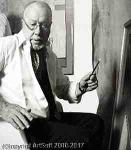Jeffrey Smart
Jeffrey Smart
Place: Adelaide
Born: 1921
Death: 2013
Biography:
Frank Jeffrey Edson Smart, AO was an expatriate Australian painter known for his precisionist depictions of urban landscapes that are "full of private jokes and playful allusions".
Smart was born and educated in Adelaide where he worked as an Art teacher. After departing for Europe in 1948 he studied in Paris at La Grande Chaumière, and later at the Académie Montmartre under Fernand Léger. He returned to Australia 1951, living in Sydney, and began exhibiting frequently in 1957. In 1963, he moved to Italy. After a successful exhibition in London, he bought a rural property called "Posticcia Nuova" near Arezzo in Tuscany. He resided there with his partner until his death.
His autobiography, Not Quite Straight, was published in 1996. A major retrospective of his works travelled around Australian art galleries 1999–2000.
Jeff Smart, as he was generally known for the first thirty years of his life, was born in Adelaide in 1921. He started drawing at an early age. "My parents would give me large sheets of paper, often the backs of posters or calendars ... anything". He was educated at Pulteney Grammar School and Unley High School, and originally wanted to become an architect. However, after studying at the Adelaide Teachers College and the South Australian School of Art and Crafts in 1937–1941, he taught art in schools for the South Australian Education Department in 1942–1947. In the early 1940s he accompanied local maritime artist, John Giles, in painting industrial landscapes at Port Adelaide. He joined the Royal South Australian Society of Arts around 1941 and was elected vice-president in 1950. It was during this period that he acknowledged his homosexuality.
Smart travelled to Europe in 1948, studying in Paris at La Grand Chaumière and later the Académie Montmartre under Fernand Léger. "As my technique grew, I found I could paint those things I liked looking at, those slum streets behind the city apartments". In 1950 he lived on the island of Ischia in the bay of Naples, where he painted with Donald Friend, Michael Shannon and Jacqueline Hick.
In 1951, he moved to Sydney and spent the next 2 years there as an art critic for the Daily Telegraph (1952–54), an arts compere called Phidias for the ABC children's radio programme The Argonauts, and a drawing teacher at the National Art School (1956–62). From 1956 to 1962, he also presented on ABC-TV's Children's Hour. Smart was also employed by The King's School, Parramatta in 1954–56 as an Art teacher, following Jean Bellette (known as Mrs Haefliger) and John Passmore. He exhibited throughout this period at the Macquarie Galleries.
Smart departed Australia for London on the Castel Felice out of Sydney just after Christmas 1963, driving to Greece with fellow painter Justin O'Brien. In 1965 he returned to Italy, and lived there for the rest of his life, regarding himself as an "Australian living abroad" and carrying an Australian passport. His last work, "Labyrinth", was completed in 2011, at which point he announced his retirement.
Smart died of renal failure in Arezzo on 20 June 2013, aged 91.
Smart is one of Australia's best known artists with his almost iconic and unique imagery, heavily influenced by various artists and art forms. His stark portrayals of contemporary life, both realistic and absurd, have been the basis of many artistic discussions. Critics and admirers of Smart's paintings often debate his subject matter but in interviews Smart has preferred not to discuss his style; "Leaving the interpretation as the prerogative of the individual viewer." Smart states that he "paints a picture because he likes the shape", and when asked why his skies are always so gloomy and smog-laden or why his faces never wear a smile, he claims "I need a dark sky for the composition, because pale blue at the top of a frame looks nothing ... [and] because a smiling face is too hard to paint".
Smart's unsentimental paintings encompass lonely urban vistas that seem both disturbing and threatening.[citation needed] Isolated individuals seem lost in industrial wastelands, full of high rise construction, concrete street-scapes and an eerie feeling of harmony and equilibrium – where silence and stillness create a deathly ambience. 'The express rape of the landscape' is one title hanging over Smart's paintings, referring to the freeways, street signs, trucks, oil drums, containers, buildings and concrete dividers that are the ever-present subjects of his work. At the same time his paintings – full of bold colours and perfect symmetry – are beautiful. The repetition of road signs in his works, for example, suggest an inconclusive direction and a world outside the frame is tantalising suggested.
Figures are present in many of Smart's paintings. These are said to be "impassive observers, reconciled to the contemporary state of things, prepared to accommodate themselves to an increasingly impersonal environment" or as "statements on the dehumanising conformity of modern architecture and social painting". According to Smart however, "the truth is I put figures in mainly for scale". It is Smart's precise and unequalled attention to clean lines, composition and geometrics that make his eye-catching paintings stand-out "in the story of modern Australian art". "The subject matter is only the hinge that opens the door, the hook on which hangs a coat. My only concern is putting the right shapes in the right colours in the right places. It is always the geometry".
More...
Wikipedia link: Click Here














